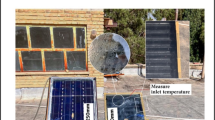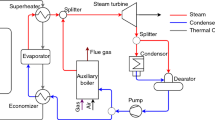Abstract
This paper presents the artificial water inflow created by the photovoltaic (PV) or solar thermal (ST) generator which pumps it into the upper water/energy storage of pump storage hydroelectric (PSH) for continuous green energy production. Formulas have been derived for the calculation of artificial water inflow created by the PV and ST generator, as well as the general formula for calculating the artificial water inflow created by solar energy and formulas for calculating the corresponding energy, all in order to assess the site location suitability for solar hydro system applications. In order to verify the obtained formulas, two sites were observed at typical climate areas, i.e. Mediterranean (Vis, 1575 kWh/m2y) and Continental (Osijek, 1262 kWh/m2y) climate of Croatia, and as expected, the PV generator provides more stable time series in both climates than the ST generator that creates high energy dissipation and therefore less reliable energy production, particularly in the areas with Continental climate. Compatibility analysis of natural and artificial water inflows, with the use of a small water reservoir, showed that the PV-PSH system can ensure a continuous supply of energy throughout the whole year, while winter energy shortages in the ST-PSH system can be solved by using a larger reservoir. The obtained results show that the integrated solar-hydro system is efficient and desirable in terms of achieving goals related to the increase of green energy production.






Similar content being viewed by others
References
Anagnostopoulos JS, Papantonis DE (2007) Pumping station design for a pumped-storage wind-hydro power plant. Energy Convers Manag 48:3009–3017
Anagnostopoulos JS, Papantonis DE (2008) Simulation and size optimization of a pumped-storage power plant for recovery of wind-farms rejected energy. Renew Energy 33:1685–1694
Beaudin M, Zareipour H, Schellenberglabe A, Rosehart W (2010) Energy storage for mitigating the variability of renewable electricity sources: an updated review. Energ Sustain Dev 14:302–314
Beluco A, Kroeff de Souza P, Krenzinger A (2012) A method to evaluate the effect of complementarity in time between hydro and solar energy on the performance of hybrid hydro PV generating plants. Renew Energy 45:24–30
Biswas J, Kim H, Choe S, Kundu PP, Park YH, Lee DS (2003) Linear Low Density Polyethylene (LLDPE)/Zeolite Microporous Composite Film. Macromol Res 11(5):357–367
Bueno C, Carta JA (2006) Wind powered hydro storage systems, a means of increasing the penetration of renewable energy in the Canary Islands. Renew Sust Energ Rev 10:312–340
Cheng CT, Wang WC, Xu DM, Chau KW (2008) Optimizing hydropower reservoir operation using hybrid genetic algorithm and chaos. Water Resour Manag 22:895–909. doi:10.1007/s11269-007-9200-1
Connolly D, Lund H, Mathiesen BV, Pican E, Leahy M (2012) The technical and economic implications of integrating fluctuating renewable energy using energy storage. Renew Energy 43:47–60
Daoutis LG, Dialynas EN (2009) Impact of hybrid wind and hydroelectric power generation on the operational performance of isolated power systems. Electr Power Syst Res 79:1360–1373
Deane JP, O’ Gallacho’ir BP, McKoegh EJ (2010) Techno-economic review of existing and new pumped hydro energy storage plant. Renew Sust Energ Rev 14:1293–1302
EREC, European Renewable Energy Council (2006) Renewable Energy Scenario to 2040, Half of the global energy supply from renewables in 2040 < http://www.censolar.es/erec2040.pdf>
ESA, Electricity Storage Association, Energy storage technologies. Technologies & Applications – Technology Comparisons, 2009 <http://www.electricitystorage.org/tech/technologies_comparisons.htm>
Glasnovic Z, Margeta J (2009a) Solar hydroelectric power plant, Patent WO/2009/118572; October 1, 2009
Glasnovic Z, Margeta J (2009b) The features of sustainable Solar Hydroelectric Power Plant. Renew Energy 33: 1742–1751.
Glasnovic Z, Margeta J (2010) Sustainable electric power system, is it possible? - Case study Croatia. J Energy Eng 36:103–113
Glasnovic Z, Rogošić M, Margeta J (2011) A model for optimal sizing of solar thermal hydroelectric power plant. Sol Energy 85:794–807
Glasnovic Z, Margeta J (2011) Vision of total renewable electricity scenario. Renew Sust Energ Rev 15:1873–1884
Gonçalves FV, Costa LH, Ramos HM (2011) ANN for hybrid energy system evaluation: methodology and WSS case study. Water Resour Manage 25:2295–2317. doi:10.1007/s11269-011-9809-y
IPCC, Intergovernmental Panel on Climate Change: Fourth Assessment Report, Synthesis report, 52p., 2007, <http://www.ipcc.ch>
Kumar AP, Depan D, Tomerb NS, Singh RP (2009) Nanoscale particles for polymer degradation and stabilization – Trends and future perspectives. Prog Polym Sci 34:479–515
Margeta J, Glasnovic Z (2010) Feasibility of the green energy production by hybrid solar + hydro power system in Europe and similar climate areas. Renew Sust Energ Rev 14:1580–1590
Margeta J, Glasnovic Z (2011a) Hybrid RES-HEP systems development. Water Resour Manag 25:2219–2239
Margeta J, Glasnovic Z (2011b) Introduction of PV energy into an existing HEP. IEEE Trans Energy Convers 26:717–727
Margeta J, Glasnovic Z (2011c) Role of water-energy storage in PV-PSH power plant development. ASCE J Energy Eng 137:187–197
Margeta J, Glasnovic Z (2012) Theoretical settings of photovoltaic-hydro energy system for sustainable energy production. Sol Energy 86:972–982
Markvart T, Castaňer L (2003) Practical handbook of photovoltaics: Fundamentals and applications. Elsevier Science Ltd, Oxford
Muche T (2009) A real option-based simulation model to evaluate investments in pump storage plants. Energy Policy 37:4851–4862
Rani D, Moreira MM (2010) Simulation-optimizationmodeling: a survey and potential application in reservoir systems operation. Water Resour Manag 24:1107–1138
Author information
Authors and Affiliations
Corresponding author
Rights and permissions
About this article
Cite this article
Glasnovic, Z., Margeta, K. & Omerbegovic, V. Artificial Water Inflow Created by Solar Energy for Continuous Green Energy Production. Water Resour Manage 27, 2303–2323 (2013). https://doi.org/10.1007/s11269-013-0289-0
Received:
Accepted:
Published:
Issue Date:
DOI: https://doi.org/10.1007/s11269-013-0289-0




